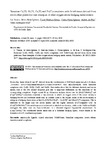Mostrar o rexistro simple do ítem
Binuclear Co(II), Ni(II), Cu(II) and Zn(II) complexes with Schiff-bases derived from crown ether platforms: rare examples of ether oxygen atoms bridging metal centers
| dc.contributor.author | Vaiana, Lea | |
| dc.contributor.author | Mato-Iglesias, Marta | |
| dc.contributor.author | Esteban-Gómez, David | |
| dc.contributor.author | Platas-Iglesias, Carlos | |
| dc.contributor.author | Blas, Andrés de | |
| dc.contributor.author | Rodríguez-Blas, Teresa | |
| dc.date.accessioned | 2020-04-02T11:09:51Z | |
| dc.date.available | 2020-04-02T11:09:51Z | |
| dc.date.issued | 2010-05-26 | |
| dc.identifier.citation | L. Vaiana, M. Mato-Iglesias, D. Esteban-Gómez, C. Platas-Iglesias, A. de Blas, T. Rodríguez-Blas, Binuclear Co(II), Ni(II), Cu(II) and Zn(II) complexes with Schiff-bases derived from crown ether platforms: Rare examples of ether oxygen atoms bridging metal centers, Polyhedron. 29 (2010) 2269–2277. https://doi.org/10.1016/j.poly.2010.04.036. | es_ES |
| dc.identifier.issn | 0277-5387 | |
| dc.identifier.uri | http://hdl.handle.net/2183/25288 | |
| dc.description.abstract | [Abstract] Bibracchial lariat ethers L3 and L4, derived from the condensation of N,N′-bis(2-aminobenzyl)-1,10-diaza-15-crown-5 or N,N′-bis(2-aminobenzyl)-4,13-diaza-18-crown-6 with salicylaldehyde, form binuclear complexes with Co(II), Ni(II), Cu(II) and Zn(II). Our studies show that the different denticity and crown moiety size of the two related receptors give rise to important differences on the structures of the corresponding complexes. Single crystal X-ray diffraction analysis shows that the [Ni2(L3)(H2O)2]2+ and [Cu2(L3)(NO3)]+ complexes constitute a rare example in which an oxygen atom of the crown moiety is bridging the two six coordinate metal ions. In contrast, none of the oxygen atoms of the crown moiety is acting as a bridging donor atom in the [Co2(L4)(CH3CN)2]2+, [Cu2(L4)]2+ and [Zn2(L4)]2+ complexes. This is attributed to the larger size the crown moiety and the higher denticity of L4 compared to L3. In [Co2(L4)(CH3CN)2]2+ the metal ions show a distorted octahedral coordination, while in the Cu(II) and Zn(II) analogues the metal ions are five-coordinated in a distorted trigonal bipyramidal environment. In [Cu2(L3)(NO3)]+ the coordinated nitrate anion acts as a bidentate bridging ligand, which results in the formation of a 1D coordination polymer. | es_ES |
| dc.description.sponsorship | Xunta de Galicia; INCITE09E1R103013ES | es_ES |
| dc.language.iso | eng | es_ES |
| dc.publisher | Elsevier | es_ES |
| dc.relation.uri | https://doi.org/10.1016/j.poly.2010.04.036 | es_ES |
| dc.rights | Atribución-NoComercial-SinDerivadas 3.0 España | es_ES |
| dc.rights.uri | http://creativecommons.org/licenses/by-nc-nd/3.0/es/ | * |
| dc.subject | Macrocyclic ligands | es_ES |
| dc.subject | Crystal structures | es_ES |
| dc.subject | Schiff bases | es_ES |
| dc.subject | Binuclear complexes | es_ES |
| dc.subject | Crown ethers | es_ES |
| dc.subject | Transition-metal complexes | es_ES |
| dc.title | Binuclear Co(II), Ni(II), Cu(II) and Zn(II) complexes with Schiff-bases derived from crown ether platforms: rare examples of ether oxygen atoms bridging metal centers | es_ES |
| dc.type | info:eu-repo/semantics/article | es_ES |
| dc.rights.access | info:eu-repo/semantics/openAccess | es_ES |
| UDC.journalTitle | Polyhedron | es_ES |
| UDC.volume | 29 | es_ES |
| UDC.issue | 11 | es_ES |
| UDC.startPage | 2269 | es_ES |
| UDC.endPage | 2277 | es_ES |
Ficheiros no ítem
Este ítem aparece na(s) seguinte(s) colección(s)
-
GI-REACT! - Artigos [107]






